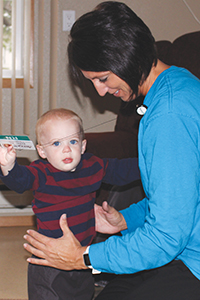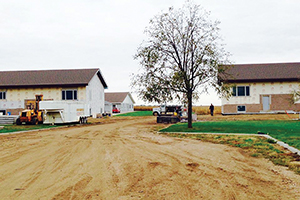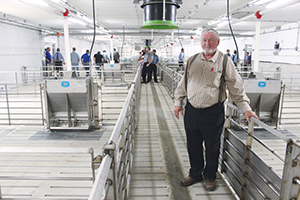By MARGARET GILLERMAN
OAK LANE COLONY, S.D. — Out on the rolling prairies of South Dakota on a crystal clear October day, waves of dust rise like smoke, signaling the progress of modern combines as Hutterite farmers harvest thousands of acres of corn.
In the communal kitchen of the Oak Lane Colony, Hutterite wives prepare a hearty mid-day dinner for their colony's main meal.
Kerri Lutjens, a registered nurse employed by Avera St. Benedict Health Center in Parkston, S.D., is at Oak Lane Colony, too. She is one of the few outsiders trusted and welcome
here and in seven other devoutly religious, cloistered Hutterite colonies near Parkston, a town of about 1,500 located about 70 miles southwest of Sioux Falls.
Lutjens visits each of the eight colonies at least twice each month. She administers vaccinations at six colonies and provides nursing services, including drawing blood for lab tests, checking patients' blood pressure and responding to health concerns
at all the colonies.
Once a month at each colony, as she is today, she is accompanied by Mary Schaefer, a certified physician assistant specializing in family medicine. Schaefer conducts pediatric and adult exams, makes diagnoses and writes prescriptions.
When there's a need for follow-up with a doctor, Lutjens calls the Certified Rural Health Clinic on the Avera St. Benedict campus in Parkston. The Hutterites are conversant in English, but they speak German in their homes and many are reluctant to interact
with others outside of their communities, Lutjens says. So Lutjens smooths the way, setting up medical appointments and functioning as an ad hoc patient advocate.
No time to wasteThe colonies visited by Lutjens are within
a 60-mile radius of Parkston, and she logs an average 2,100 miles a month making her rounds.
Until Avera St. Benedict inaugurated its outreach program two years ago, local Hutterite colonies made limited use of preventive care and missed out on other routine medical care, says Gale Walker, president and chief executive of Avera St. Benedict.
The intensely private, camera-shy Hutterites reject many modern conveniences, choosing to live communally in simplicity to avoid worldly temptations. Most do not oppose vaccination, nor are they averse to medically advanced treatment, Walker says. Hutterites
seek medical care in emergencies and for serious chronic illness. But the time and distance required to travel to a clinic had been a big impediment to obtaining preventive care. The colonies are relatively remote and the demands of the Hutterites'
self-sufficient lifestyle, including work, family life and religious observation, leave little time unspoken for. The men work daily on communal grain and dairy farms, in sizeable turkey or hog operations and in construction at the colonies. At the
Oak Lane Colony, women are occupied with child rearing, household tasks, tending communal vegetable gardens and taking their turns cooking three daily meals for the 100-plus residents.
The eight colonies visited by Lutjens have a combined population of about 900; most have a population of around 100 people.
Immunization champion

Kerri Lutjens, an Avera St. Benedict Health Center nurse, examines Roman Hofer at his home in the Tschetter Colony. She vaccinated his older brother, but Roman didn’t need a shot today.
Walker said that before Lutjens started giving inoculations in the colonies, only "a dismal 20 percent" of the Hutterite children had been vaccinated for childhood diseases or were up-to-date on vaccinations.
In the two years she's been delivering outpatient care in the colonies, Lutjens has given more than 900 vaccinations, including all the state-recommended childhood vaccinations. Vaccinations for adults include pneumonia, shingles and Tdap (tetanus, diphtheria
and pertussis). Now, more than 90 percent of the children in the six colonies where she administers vaccine are up-to-date on their inoculations, Walker says. (A community health nurse provides vaccinations in the other two colonies visited by Lutjens.)
The Centers for Disease Control and Prevention in April named Lutjens South Dakota's 2015 Childhood Immunization Champion for her work "promoting childhood immunization through culturally-sensitive educational efforts."
"Before Ms. Lutjens started reaching out to the colonies, the importance and value of immunizations was not widely known or understood" in those communities, the CDC said. "Families now initiate the communication and often reach out to her."
Trust building
Avera St. Benedict Health Center is comprised of the clinic; Avera St. Benedict Hospital, a 25-bed critical access hospital; a 48-room nursing home and 25-bed assisted living center; a wellness center that includes
rehab services; and outreach care. St. Benedict has up to 50,000 patient contacts a year, Walker says.
Walker made the decision to invest limited resources to deliver regular medical care to the Hutterite colonies after visiting the communities himself to talk about how Avera could respond to unmet health needs, and, in the process, win the communities'
trust and health care business.
Lutjens was a natural for the outreach assignment, Walker says, because she was known and trusted by many residents of the colonies from work she did on an earlier health care project. "It's all about trust," he adds.
Says Lutjens: "Mr. Walker and I sat down and hashed out a plan for what we could offer the Hutterites &mash; and then I went out on a wing and a prayer."
Says Walker: "We knew that the colonies had health care needs. This was our endeavor to help. Kerri has the full support of the (Avera St. Benedict) facility — the docs, X-rays, labs, nursing staff, the clinic."
By improving health access, Walker says he hopes to encourage the Hutterites to make disease prevention and wellness a priority.
There is another advantage to delivering quality care and gaining the confidence of the Hutterite community: Avera St. Benedict hopes to build its patient base at a time when the population of its service area continues to shrink, Walker says, preserving
health care services for all in the region.
Kitchen table care
Lutjens knows her patients by name. She attends communal dinners and uses what she calls "the kitchen table talk" approach to gain trust. "I have coffee and we talk," Lutjens says. "Many don't feel good about
going out in public. They do feel comfortable in their own homes."
In addition to her regular visits, Lutjens says she "pops by whenever I can when anyone wants anything." Walker says members of the Hutterite communities contact Lutjens days, nights and weekends. "Kerri is a very special person," he says. "The Hutterites
have her cell phone number."
When a baby from one of the Hutterite colonies was diagnosed with whooping cough last year, Lutjens immediately headed out to the colonies to vaccinate children and adults. She convinced reluctant adults to take the shot by saying: "Do it for all the
babies on the colonies."

A cluster of homes under construction at the Oak Lane Colony.
House call
On this October day on a stop at the New Elm Spring Colony, Lutjens uses the colony's speaker system to announce the arrival of the Avera St. Benedict crew — herself, Schaefer and Julie Semmler, the health center's
corporate communications coordinator. Lutjens also makes phone calls to invite some of the 23 families to the temporary clinic the trio set up at the colony school. For much of the morning, mothers bring their neatly dressed children for shots
or exams. Some adult patients also stop by.
"Hey, Buddy, how are you feeling?" Lutjens asks a child who gets regular allergy shots.
"Have you guys been wearing your (bicycle) helmets?" she inquires of other children.
After the exams, Lutjens and Schaefer log the patients' data into Avera St. Benedict's electronic patient record system, which connects with the Avera multi-state system.
At Oak Lane, the second colony on the Avera team's circuit today, Lutjens and Schaefer make a house call to the Grosz family. Stacy Grosz says the family feels very comfortable with the Avera health workers. Joshua Grosz says the family appreciates that
Lutjens comes to the colony.
"It's much easier than going all the way into the clinic," he says. Oak Lane lies about 20 miles from Parkston on winding country roads. In winter, Lutjens braves some large icy hills between Parkston and the colonies.
Lutjens and Schaefer transform the colony's cheerful children's dining hall into a temporary clinic for their visit. One patient is a four-year-old boy who sustained an eye injury while playing. Lutjens asks the parents to continue to update her on his
recovery.
"They text me all the time," Lutjens says of the child's parents.
Out the window, a parade of young children, with the little girls in bonnets, skip and ride by on bicycles. Inside the spotless kitchen, five women stir soups in stock pots, prepare chicken and set out 20 apple pies to cool before dinner.
Hutterites hold to a lifestyle that avoids worldly temptations
 John Wipf, business manager of Oak Lane Colony, was on hand at an August open house to show the public the community’s four new hog finishing barns, where the drug-free animals are fattened for slaughter.
Photo credit: Anna Jauhola/The Daily Republic OAK LANE COLONY, S.D. — For Joshua and Stacy Grosz and other Hutterites, religion, family, work and the good of the community are the focus of their lives. "We don't have televisions, radios or computers" at home, says Joshua Grosz, 47. (Hutterites do use basic cellphones.) When not working or praying, "we spend our time with our families," he says. Grosz, his wife Stacy, 35, two preschool-age sons, and Joshua's mother, Susana, live together in the Oak Lane Colony, about 20 miles down country roads from Parkston, S.D. One of the newer Hutterite communities, it has a population
of about 100. Like the Grosz family, most Hutterites in the Upper Midwest live and work communally, pooling their earnings and relying on the community for housing and other household needs. Workers get a small monthly allowance. The Hutterites'
lifestyle is modeled on that of some of the earliest Christians. The single family and attached homes are clustered near the central hall, where all meals are shared in the adult or children's dining rooms. Normally Hutterites have limited contact with the outside world by choice, to avoid worldly temptation, but in August, Oak Lane invited the public to tour its new 10,000-head hog operation and barn complex. Hutterites dress modestly — women in long skirts and head scarves and men in plaid shirts with suspenders and long pants. Many of the children dress like small adults, with the young girls wearing bonnets. They speak German as their primary language, and in their homes, following the tradition of their ancestors. Hutterites hold Anabaptist beliefs, including that Baptismal candidates should be mature enough to profess their faith. Their
religious prayers are those written in the 1500s, according to Anabaptist references. Most Hutterites live in small colonies — with an average of about 100 people — in South Dakota, North Dakota and surrounding states with the largest number in Canadian provinces in the West, says Kerri Lutjens, an Avera
St. Benedict Health Center nurse who brings medical care to Hutterite communities in the Parkston area. The colonies are connected by common faith and sometimes marriages but most do not share businesses, she says. Some are considered "daughter" colonies and were formed when others got too large. Each colony is run by an elected minister. Joshua Grosz learned his trade — building, carpentry and construction — on the job. "We build our houses from the cement up to the top," he says. Most of the sturdy oak furniture in the Grosz home was handcrafted at another
Hutterite colony or by Grosz. In South Dakota, colony children are educated through eighth grade in public schools at the colonies by both a German-speaking teacher who teaches reading and writing in German and by an English-speaking teacher. At New Elm Springs
and some other colonies, computers are used for a "virtual" high school. Hutterites attend religious services seven nights a week and go to Sunday morning service. Because of their pacifist beliefs, they are conscientious objectors during times of war. Their religion grew out of the Radical Reformation of the 16th century in an area that is now Germany, Austria and Switzerland, and the first congregation was led by Jakob Hutter in Moravia. Persecuted for their beliefs in Europe,
the Hutterites moved around frequently, including to Russia and finally to North America, arriving in South Dakota in the 1870s. They also faced discrimination in World War I in the United States, and many left for Canada. To learn more about the Hutterites, visit Hutterites.org.
Watch the BBC documentary, "How to Get to Heaven with the Hutterites" —MARGARET GILLERMAN |
Copyright © 2015 by the Catholic Health Association of the United States
For reprint permission, contact Betty Crosby or call (314) 253-3477.